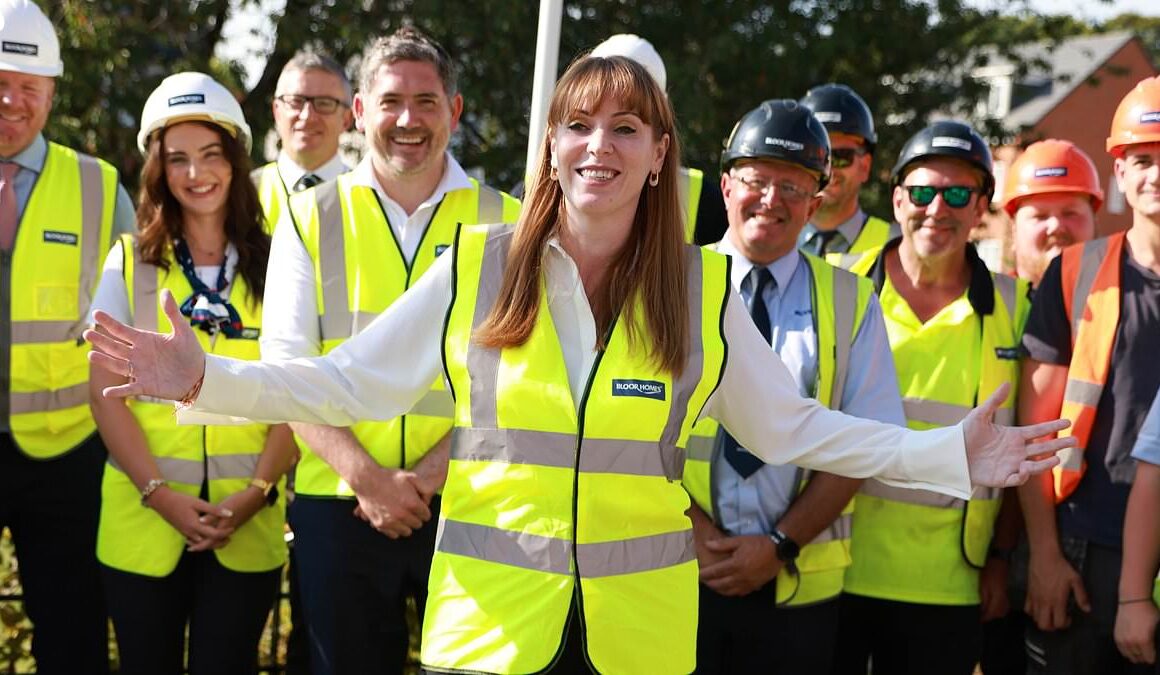Parts of England were warned they face a sevenfold increase in housebuilding last night after Angela Rayner tore up planning protections for the countryside.
In her first major intervention in Government, the Deputy Prime Minister announced she was imposing ‘mandatory’ targets on local authorities in a bid to address the ‘unforgivable’ housing crisis.
The moves are expected to result in at least 100,000 new homes being built on the Green Belt, after Ms Rayner watered down restrictions on building.
She also confirmed that the Government was ditching requirements on developers to produce ‘beautiful’ homes – prompting the Tories to warn she will unleash a rash of ‘ugly’ developments across the countryside.
Councils will also lose the power to block developments deemed to be ‘out of character’ with a local area.

Parts of England were warned they face a sevenfold increase in housebuilding last night after Angela Rayner tore up planning protections for the countryside

In North Yorkshire, where Rishi Sunak is an MP, the previous target to build 1,361 homes a year has been trebled to 4,232
Labour has a target to build 1.5 million homes over five years - equal to 300,000 a year. But Ms Rayner yesterday imposed targets that would result in 370,000 homes a year being built.
She warned that councils which refuse to comply face being stripped of their planning powers.
The new targets will lead to astonishing increases in housebuilding in some parts of the country. Many of the areas facing the biggest increases are in traditionally Tory parts of the country in the South.
In Fareham, in Hampshire, where Suella Braverman is MP, housebuilding was ordered to rise from a current level of 115 homes a year to a staggering 794 - an almost sevenfold increase.
In North Yorkshire, where Rishi Sunak is an MP, the previous target to build 1,361 homes a year has been trebled to 4,232.
In Hertsmere, where former deputy prime minister Oliver Dowden is MP, current building of 277 homes a year will have to rise to 959.
Some Labour areas were also hit. The target for Redcar and Cleveland will rise from just 45 new homes a year to 642.
But the target in London, where Labour's Sadiq Khan is in charge of housing delivery, the target was slashed from almost 100,000 to just over 80,000.
In a wide-ranging statement, Ms Rayner also:
- Risked hypocrisy by ordering a review of the Right-to-Buy scheme she benefited from herself.
- Unveiled plans to reclassify large swathes of 'low quality' Green Belt as 'grey belt', where planning restrictions will be far looser.
- Pledged a 'revolution' in council house building.
- Launched a consultation on whether to double the cost of a planning application from £258 to £528.
- Prepared to unveil a new 'task force' to identify sites for a string of 'new towns' of at least 10,000 homes each.
Kemi Badenoch accused Ms Rayner of giving the go-ahead to build '1.5 million ugly homes' across the country.
The shadow housing secretary criticised the government's decision to axe the requirement to build beautiful homes, saying it 'means so much to local communities' and people 'deserve to live in beautiful homes'.
She also warned the changes proposed by Labour would result in the 'worst of all worlds' by 'centralising decision-making' and failing to address the 'basic economics' of housebuilding.
Former housing secretary Michael Gove scrapped mandatory housing targets last year, saying they were ineffective.
But Ms Rayner said the decision had contributed to a slump in housebuilding, with the number of new homes expected to fall below 200,000 this year.
In a statement to MPs 'In a bid to appease their anti-housing backbenchers, they made housing targets only advisable.

A graphic showing how different communities will be impacted by the new housing targets

The new, higher targets have been produced by a complex algorithm, which tries to predict what housing demand would be in an area if house prices were lower

Ms Rayner, pictured arriving in Downing Street this morning, told MPs new local housebuilding targets would include 'an uplift where house prices are most out of step with local incomes'
'They knew that this would tank housing supply, but they still did it.' She said her 'radical plan' would help 'get the homes we desperately need' and boost economic growth.
The new, higher targets have been produced by a complex algorithm, which tries to predict what housing demand would be in an area if house prices were lower.
Ms Rayner admitted the change was 'not without controversy' and acknowledged the algorithm meant that some areas would 'get a surprising target'. But she said 'no method is perfect'.
Mr Gove's former Surrey Heath constituency will have its annual housing target doubled from 320 to 658.
Councils will be ordered to incorporate the targets into their local plans. Those that fail to do so risk having their planning function taken over directly by central government.
Roger Mortlock, chief executive of the rural campaign group CPRE, warned against allowing a free-for-all on the Green Belt, which was introduced to prevent urban sprawl.
Mr Mortlock said the Green Belt should be protected and 'not run down and then built on by profit-hungry developers'.
He said at least 1.2 million homes could be built on previously developed brownfield sites. But government sources said much of this was in unsuitable locations, meaning hundreds of thousands of homes are set to be built on green field sites.








